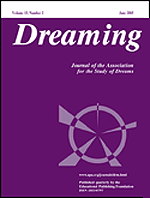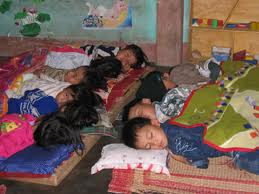From numbers to narrative: The SDDb makes it easier than ever to combine quantitative and qualitative modes of dream research. It’s possible to look only at numbers when studying dreams, just as it’s possible to look only at their narrative qualities. But now that digital archives provide the ability to do both in a variety of creatively coordinated ways, there’s no reason you have to choose one method or the other.
In fact, the burden is now on single-method researchers to explain why their investigations would not be enriched by the easy integration of other methods. For those of us who have long struggled to explain and defend the advantages of multidisciplinary research, this is a satisfying turn of the tables.
Back to the children’s dreams: After using the word searches to highlight some large-scale patterns in this set of 622 dreams, I’m ready to look into the dream narratives themselves.
Depending on your original question, you may want to start reading a set of dream narratives at the very outset, or you may want to extend the statistical analysis even further than I have up to this point. Given my initial interests, I have enough statistical information by now to feel comfortable going ahead and reading selected dream reports with a focus on details that relate to special themes I’m studying in terms of “big dreams.”
I start with death, in part because I’m curious what kids are thinking, feeling, and imagining about the end of life. I’ve also found in past studies that dreams relating to death are often connected to bigger religious/spiritual beliefs in the individual’s life. Guided by that, I often begin reading my way into a set of dreams through the reports using death-related words.
Here are some of the children’s dreams about death that illustrate recurrent themes found elsewhere in the set, along with my initial notes about what might be going on.
“I remember having a dream that my mom died. I couldn’t recall where I was. All I could think about was who was going to take care of us. I felt scared. I don’t remember how my dream ended.” (boy, 17)
Many of the death-related dreams involved a mortal threat to parents or family members. This surely reflects a primal fear in child psychology.
“I had a dream a couple of nights ago about my mom dying and I couldn’t save her. It was very hard to understand why I had a dream like that about my mom.” (girl, 9)
Here is the same theme, with an extra emphasis on the child’s futile efforts to stop death. The dream pushes her waking mind to consider something it does not understand but can’t help wondering about.
“My mom and dad were in the house with me and there were ghost versions of my mom and dad. The ghost versions of my parents let me play computer games and do whatever I wanted and they were yelling a lot. They shot the real versions of my parents and then my parents died. I cried but then Jesus showed up with me. This was a vivid nightmare i had when I was 8.” (girl, 15)
There’s more bizarreness in this dream, which may reflect metaphorical dimensions of meaning (hard to explore without the ability to dialogue with the dreamer). She is scared of the death not of her parents but of their disciplined care for her (their superego function?), which is then replaced by the companionship of Jesus. What does this say about the adolescent psychology of religion?
“One night when I was about 15 years old I had a dream that I was at home and everyone was sleeping when we got a phone call saying that my grandfather had died. The next morning after I had woken up from the dream I went downstairs and my mother was crying. My grandfather had been put into the hospital after a heart attack but luckily he made it through.” (girl, 15)
Strange things happen in families during times of grave illness and death. Perhaps the girl subliminally heard the phone call while sleeping and incorporated it into her dream, or perhaps her dreaming mind picked up on the emotional stress of her family through means we do not yet understand and wove it into an adaptive preparation for the crisis in waking life.
“I played with my dog Lita that died 2 years ago. i took her on a walk to our favorite rock and she licked my face. I was so happy. I wished it was real.” (girl, 10)
There are several visitation dreams in the set, some with family members and some with animals. It’s a dream of happiness and mourning that spurs waking reflection on the relation of wishes and realities.
“It was about my cat Nick he died over a year ago and I dreamt that he came back to life to hang with me and my family this happened about a month ago it felt so real that when I woke up and saw he was not there I was so sad.” (girl, 11)
A similar kind of visitation dream prompts waking feelings in relation to loss of a pet. Is this type of dream a cruel reminder that would be better ignored, or is it part of the lifelong psychological process of coping when loved ones die? Could it also be a dawning insight into the existential fact of mortality for all of us, animals and humans alike?
“I had a dream a few days ago that I was in Japan in the 40’s. I was there when one of the bombs dropped from either Heroshima or Nagasoki. I don’t know which one. But I remember seeing the huge mushroom cloud engulf the city the cloud was right in front of me. I didn’t feel afraid. I felt accepting of whatever death was about to come. I was 15 when I had this dream.” (girl, 15)
A spiritually precocious dream in which the girl imagines herself into the iconic scene of nuclear horror that defined the nightmares of the 20th century. She describes an unusual emotional calm as she accepts the inevitability of death. It would be very interesting to know more about this girl! Her experience resonates with the mystical dream traditions of many cultures, where apocalyptic imagery can herald moments of existential insight and self-transcendence.
Next: What can be learned from these findings
 In the current issue of the IASD journal Dreaming (Vol. 22, No. 4, pp. 240-252) I have an article with results of a blind word search analysis of a teenage girl’s dream series. (Many thanks to the anonymous dreamer, “Bea,” and to Bill Domhoff for mediating our interactions.) The article is my latest effort at developing a method of using statistical patterns in word usage frequency to identify meaningful continuities between dream content and waking life concerns. I think the results show that we’re making good progress. Here is the abstract of the paper:
In the current issue of the IASD journal Dreaming (Vol. 22, No. 4, pp. 240-252) I have an article with results of a blind word search analysis of a teenage girl’s dream series. (Many thanks to the anonymous dreamer, “Bea,” and to Bill Domhoff for mediating our interactions.) The article is my latest effort at developing a method of using statistical patterns in word usage frequency to identify meaningful continuities between dream content and waking life concerns. I think the results show that we’re making good progress. Here is the abstract of the paper:



 Children’s Dreams: Notes from the Seminar Given in 1936-1940 by C.G. Jung, edited by Lorenz Jung and Maria Meyer-Grass, translated by Ernst Falzeder with the collaboration of Tony Woolfson (Princeton University Press, 2008).
Children’s Dreams: Notes from the Seminar Given in 1936-1940 by C.G. Jung, edited by Lorenz Jung and Maria Meyer-Grass, translated by Ernst Falzeder with the collaboration of Tony Woolfson (Princeton University Press, 2008).